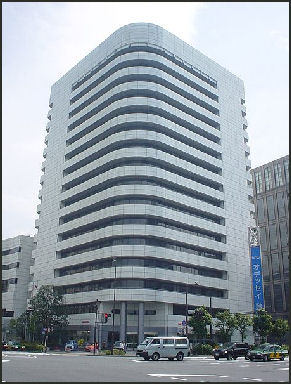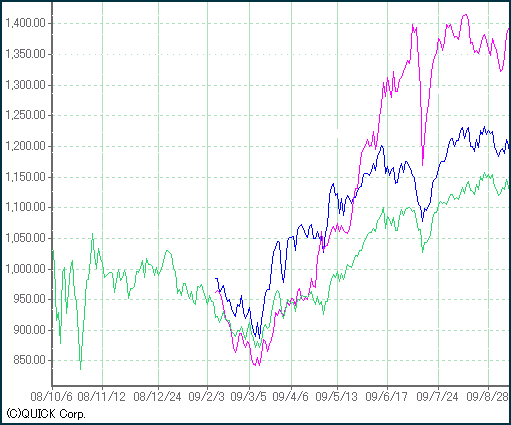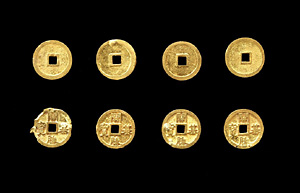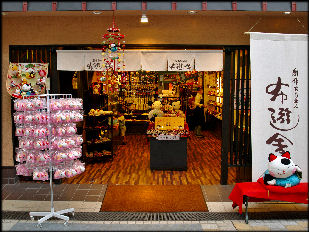JAPANESE COMPANIES

Honda headquarters Japanese companies have traditionally put the welfare of their employees over making profits and regarded creating secure jobs for their employees as being more important that paying dividends to their shareholders. Companies are often resistant to making changes that sacrifice the well-being of employees in the name of increased efficiency.
Many large Japanese companies have names linked with sun. They include Hitachi ("Sunrise"), Asahi ("Rising Sin") and Nissan ("Sun Origin Industries").
More than 90 percent of Japanese companies sell mostly to the domestic market. Japanese businesses are beginning to look more and more towards Asia for growth potential at home and than North America and Europe. They are also looking more to new markets in emerging nations as sales in Japan and the developed world fail to grow.
Some companies have gotten into debt because of permissive accounting rules and refusing to release detailed financial information, Analysts try to determine company health by studying ties between the main banks and “keiretsu” business groups.
The largest companies in Japan are Toyota, Mitsubishi and Mitsui Trading. Japan ranked second behind the United States on the Fortune 500 list of top global companies with 68 companies making the list in 2009, compared to 140 in the United States. According to Interbrand, six of the world’s top brands were based in Japan in 2003, compared to 65 in the United States.
Overseas success is important for Japanese companies. Sony and Honda both had to succeed in the American market before they were taken seriously in Japan.
Websites and Resources
Good Websites and Sources: Good Photos at Japan-Photo Archive japan-photo.de ; Companies Listed by Category japanpages.com ; Companies Listed by Industry mizuho-sc.com ; Links for English-Language Sites of Japanese Listed Companies mizuho-sc.com ; Company Histories (Shashi) at the University of Hawaii hawaii.edu/asiaref/japan/company ; Translation Tools mizuho-sc.com ;
Links in this Website: JAPANESE STOCK MARKETS Factsanddetails.com/Japan ; BANKS AND FINANCIAL SCANDALS IN JAPAN Factsanddetails.com/Japan ; RETAILING IN JAPAN Factsanddetails.com/Japan ; TRADE AND OVERSEAS BUSINESS IN JAPAN Factsanddetails.com/Japan ; BUSINESS CUSTOMS AND PRACTICES IN JAPAN Factsanddetails.com/Japan ; MACROECONOMICS IN JAPAN Factsanddetails.com/Japan ; JAPAN INC. AND REFORMS Factsanddetails.com/Japan ; ECONOMIC HISTORY OF JAPAN AFTER THE 1970s Factsanddetails.com/Japan ; ECONOMIC REFORMS AND RECOVERY IN THE 2000s Factsanddetails.com/Japan ; JAPAN AND THE GLOBAL ECONOMIC CRISIS IN 2008 AND 2009 Factsanddetails.com/Japan ;
Good Websites and Sources on Business: Statistical Handbook of Japan Finance Chapter stat.go.jp/english/data/handbook ; 2010 Edition stat.go.jp/english/data/nenkan ; News stat.go.jp Financial Services Industry fsa.go.jp/en Business News: Far Eastern Economic Review www.feer.com ; Nikkei.com nikkei.co.jp ; Japan Corporate News japancorp.net ; Wall Street Journal Asia asia.wsj.com ; Japan Investor japaninvestor.com ; Japan Economy Watch japanjapan.blogspot.com ; Japan Center for Economic Research jcer.or.jp/eng ; Japan Inc. Economic and Business News japaninc.com
Marketing Japan Marketing News /japanmarketingnews.com ; Plunkett Research plunkettresearch.com ; Research and Markets researchandmarkets.com ; Asaho Shimbun Market Trends asahi.com/english/market ; Business Organizations Japanese Business Organizations mizuho-sc.com ;Keidanren (Most Powerful Business Group in Japan) keidanren.or.jp ; Keizai Koho Center, Keidanren’s Research Arm kkc.or.jp/english Entrepreneur Association of Japan ea-tokyo.com ; Bizfinder Directory of Trading Companies ebiz.co.jp/bizfinder ; Business Customs and Practices: Culture- at-Work culture-at-work.com ; Executive Planet executiveplanet.com ;Tips on Doing Business in Japan cyborlink.com ; More Tips on Doing Business in Japan euro-technology.com ; Kwintessential kwintessential.co.uk
Japanese Companies and Their Workers
Many workers work for one company their entire life. Japanese firms traditionally invested large amounts of money training their workers, which is one reason why they demand company loyalty. There has traditionally been a strong social stigma attached to job-changing.
Corporate life in Japan includes subsidized dormitories with cramped rooms and shared bathrooms for single employees, company-sponsored drinking binges and corporate outings and visits to the company founder’s ancestral grave. There are even company-sponsored sports festivals with dodge ball and rope skipping.
Many workers have little other identity other than the company they work for. “ Soshikiryoku” is a term used to describe team spirit and togetherness that Japanese corporations try to foster and promote to motivate employees, get them to work together and keep morale high. This contrasts with the individualistic, dog-eat-dog competition and merit-based pay promoted in Westerner corporations.
Companies are regarded as social organizations not just a collection of financial and physical assets. The company is regarded as something that belongs to the employees not the shareholders. Bosses make personal visits to employees families. They take care of hospital arrangements for sick workers. Directors and managers usually come from within a company rather than outside it.
Many employees at Japanese companies start the day with calisthenics and rousing renditions of the company song. See Industries, Panasonic

Japanese Companies and Stockholders
Japanese companies have traditionally given out very small dividends and instead kept the bulk of their profits as reserves.
Companies usually hold shareholder meetings only once a year. These meeting are usually staid affairs heavy on formalities and light on sticky questions. Shareholders usually go along with the board of directors decisions without making ripples.
Although many companies have stocks held by private citizens, public shareholders meetings often last less than 20 minutes and speakers are protected from verbal abuse by paid management supported by “sokaya” who occupy most the seats around the podium.
Many Japanese firms have their shareholder meetings in late June. More than 1,000 firms held shareholder meetings in June 2010. Among those that had highly-publicized meetings in late June 2011 were Sony, TEPCO, Nissan, Mizuho Bank and Sumitomo Mitsui Financial group.
An unassuming former bureaucrat named Tomomi Yano has become a major activist for shareholders rights and a critic of the too chummy relationship between companies and their institutional investors. As the head of an $11 billion state-run pension fund, he said he would no longer automatically support management at the more than 1,000 companies his fund has invested in unless the companies meet certain criteria such as paying annual dividends to shareholders.
World’s Oldest Company

8th century gold coins In Japan there are more than 100,000 companies that have been in business for more than a century. There are over 100 that have been in operation since the 14th century.
The world’s oldest company is the Osaka-based, construction firm Kongo Gumi. Owned and operated by the Kongo family since A.D. 578, a century after the fall of Roman empire, it has survived feudal wars, earthquakes and the bursting of the bubble economy. Its first job — the construction of the Shitennoji temple in Namba, Osaka — was in A.D. 593. It racked up sales of $85 million in 2001. Its CEO is from a 40-generation family line.
The secret to Kongo Gumi’s success, its owners say, has been staying focused on what it has done best over the centuries: building Buddhist temples and Shinto shrines. But at the same it has not shied away from innovations. The company was one of the first in its field to use concrete instead of wood and employ computer-aided designs.
A survey in 2009 found that there over 21,000 firms over 100 years old in Japan and eight firms over 1,000 years old.The second oldest company is Ikenobo Kadokai. Founded in A.D. 587, it offers classes in flower arranging.
Small Companies and Entrepreneurs in Japan

small novelty shop While large companies like Panasonic, Sony, Toshiba, Toyota and Honda are best known, Japan’s unknown small and mid-size companies account for round for 75 percent of Japan’s manufacturing and employ 90 percent of factory workers.
Small businesses employ one in four Japanese workers. In 2000, there were 4 million of small businesses, employing 20 people or less. More than half the workers in manufacturing are working for companies with 100 employees or less. A lot of big corporations rely on smaller companies to do contract work for them.
According to Global Entrepreneurship Monitor in 2002, entrepreneurial spirit is low in Japan despite the availability of cheap loans. Only 2 percent of the population was involved in starting business in the previous 48 months compared to 14 percent in China and 12 percent in South Korea.
Number of entrepreneurs per 100 adults aged 18-64: 1) Mexico (18); 2) New Zealand (18); 3) Australia (16); 4) South Korea (15); Brazil (14); 5) the United States (12); 6) Canada (11); 7) Italy (10); 8) France (7); 9) Germany (7); 10) the Netherlands (6); 11) Japan (5). [Source: Global Entrepreneurship Monitor).
Entrepreneurs have traditionally had a difficult go of it in Japan, partly because they had difficulty securing financing from banks and investors. Banks and corporations have traditionally worked together and ignored entrepreneurs.
Rising unemployment and company restructuring has created a pool of employees more willing to take risks and open new businesses To encourage entrepreneurs, the government has made the cost of starting a business as little as ¥1. There have been few takers.
Executives and Managers in Japan

In the late 1990s, Japanese CEOs earned $300,000 to $500,000 a year, comparable to what European CEOs earned but less than American CEOs who earned an average of $1.5 million a year. The average ratio of the salary of a Japanese CEO to a Japanese blue-collar worker is 11:1. The average ratio of the salary of an American CEO to American blue-collar worker is 476:1.
Company presidents are viewed as absolute monarchs. "Retired" executives sometimes still run companies. Many Japanese companies have board of directors with dozens of members. Toyota, for example, at one time had 56 directors. Discussions and decisions become cumbersome and inefficient with that many board members. Sony trimmed its board from 38 to 10 to be more responsive.
In a move that was called "a horn blast heard throughout the industry" in the late 1990s Honda began experimenting with the idea or removing people from management posts if they hadn;t been good managers. Concerned about being branding as insensitive, Honda gave its managers up to 12 years to prove their unworthiness. Those that fail returned to non-managerial positions at 70 to 90 percent their old salaries.
For Japanese companies the ages of CEOs is declining and more foreigner are being asked to take top executive positions and serve on boards.
As of 2010, the Financial Services Agency began requiring companies too disclose the salaries of executives earning more than ¥100 million ($1.15 million) a year. Among the highest paid executives in 2010 were Hiroshi Mitsuhura, the president of the drug company Nihon Chouzai, who received ¥477 million; Masato Matsura, President of Avex recording company, who earned ¥249 million; and Panasonic Chairman Kunio Nakamura, who earned ¥122 million.
See Sony, Nissan.
Late Casio Chairman Highest-Paid Japanese Executive in 2011
Former Casio Computer Co. Chairman Toshio Kashio was the top earner among executives at listed domestic companies in fiscal 2011, according to Tokyo Shoko Research Ltd., Jiji Press reported. Kashio, who died of pneumonia in May 2012 at the age of 87, received 1.33 billion yen ($16.9 million) in remuneration, more than the 987 million yen ($12.5 million) earned by Nissan Motor Co. President Carlos Ghosn, who came in second after taking the top spot for two consecutive years. [Source: Jiji Press, June 30, 2012]
“Kashio, the second eldest of four brothers who founded Casio, accepted the pay as a special allowance when he resigned as chairman last year. He was the first executive to earn more than 1 billion yen in annual remuneration since the disclosure of the names of executives paid more than 100 million yen began in fiscal 2009, the research company said. Kashio worked mainly as an engineer and developed the Casio Mini, which went on sale in 1972 as the world's first personal electronic calculator.
Japanese Managers
Miki Tanikawa wrote in the New York Times: “Human resources officials at some big Japanese firms acknowledge that their managers have not been the most culturally suave leaders with refined management talent. “We recognize that Japanese managers have often had arrogant or disdainful posture towards the local staff, especially in Asia,” said Mr. Noda of Mitsui. “The oft-made criticism of Japanese companies is that managers make decisions exclusive of local staff, who find themselves out in the dark as to what’s going on. We want to change this.” [Source: Miki Tanikawa, New York Times, October 19, 2011]
“For those managers in Tokyo who are around 40, typical age of our participants, their next position might be the No. 1 or 2 position at overseas subsidiaries,” Naoshi Takatsu, executive vice president and Tokyo representative for IMD, told the New York Times. “The domestic market is not growing and available positions at home are limited. Jobs with big responsibilities are overseas” for shosha [trading company] managers.
Managers Sent Overseas to Give Japan an Edge
Miki Tanikawa wrote in the New York Times: “Japanese corporations are expressing growing interest in enrolling more of their managers in executive education programs overseas, acknowledging a need to make their organizations more globally oriented at a time when their home market is projected to shrink. The change reflects a long-term evolution of Japanese companies’ love-hate relationship with Western business schools. A massive defection of company-sponsored business graduates to foreign firms in the “80s and “90s sparked enmity of sorts among big Japanese companies, which today send fewer of their workers to overseas schools for full-fledged master of business administration degrees. [Source: Miki Tanikawa, New York Times, October 19, 2011]
“But now, students like Koh Akiyama, a medical products manager and a 25-year veteran at Sumitomo Corp., a giant trading company, say they see a different conclusion. Mr. Akiyama, who attended the advanced senior management program at Insead, a business school in Fontainebleau, France, said he was eager to apply what he learned back in Tokyo. “It was very refreshing and useful for me,” he said. “You get to see things in a different light and grasp logically what you’d normally only see vaguely in your normal routines.”
“He interacted in role-playing exercises with a group of managers from a number of European companies as well as from firms from China, India, Singapore and South Africa and came away with a simple conclusion: “At the end of the day, we all think alike and encounter similar problems in our management routines,” he said.
“Japanese managers and their corporate sponsors say they are finding new usefulness in the executive education programs at European and American business schools, which they say suit the needs and the organizational setup of Japanese firms much better than has the traditional M.B.A. meant for younger business people.
“Sumitomo decided to send 30 managers annually to overseas executive programs in 2010, up from just a few each year, and has custom-designed a training program with IMD, a business school based in Lausanne, Switzerland. Mitsui & Co., another trading company, which had been sending 20 to 30 managers to senior management programs overseas, has decided to up the ante: starting this year, the company will send an additional 30 senior staff annually to Harvard Business School for a tailor-made program, which complements what the company dubs Mitsui HBS Global Management Academy, a four-week management training program meant for elite managers in their early 40s.
“We need to aim for a global organization when the home market is no longer expected to grow,” said Kenji Noda, deputy general manager of human resources and general affairs at Mitsui in Tokyo. Big Japanese companies like his often have a presence worldwide, “but we are not exactly global organizationally,” he said. “We are actually quite domestically oriented in many ways.”
“Among the growing lists of companies on the client roster, said Naoshi Takatsu, executive vice president and Tokyo representative for IMD, are leading Japanese trading firms like Sumitomo, as well as consumer brand companies like Shiseido and Kao. “One of the biggest challenges for them is to train an army of skilled corporate managers, especially for trading companies,” Mr. Takatsu said.
Yakuza and Business
The yakuza have infiltrated banks, large corporations and stock traders. According one estimate almost half all yakuza members are involved in business crime or legitimate businesses. One yakuza expert told the Washington Post, "They have spread the power to every corner of society. Wherever there is money there is yakuza."
When the Japanese economy grew, the yakuza expanded and move away from small time debt collection and pimping into more profitable white collar crimes such as extortion, fraudulent stock trading and shady real estate dealings. The yakuza has made millions of dollars from legitimate business such as stock trading and the running of restaurants in Honolulu, Paris and Buenos Aires. In 1999, one gangster owned one million Japan Airlines shares. A group of gangsters founded their own bank in California.
Police have identified more than 800 yakuza front companies in Tokyo alone. They include investments and auditing firms, construction companies and pastry shops. In many ways the yakuza white-collar gangsters are like regular businessmen until thing don't go their way and they threaten violence.
Yakuza, the Stock Market and Companies
The yakuza have a significant presence in Japanese financial markets. Japan’s Securities and Exchange Surveillance Commission knows of at least 50 major companies with ties to organized crime. The yakuza has reportedly deeply infiltrated companies listed on the Osaka Stock Exchange. Authorities have raised the idea of reviewing all listed companies and expelling those with mob ties.
Japanese corporations routinely deal with gangsters and “sokaiya” (corporate extortionists) and pay off losses to valued clients. A Japanese economic professor told AFP, "A lack of corporate morality is one of the most pressing problems the country has to tackle."
By misusing the credit guarantee system for small and mid-size companies, two members of the Yamaguchi-gumi crime syndicate swindled 20 financial firms out of $48 million. Nationwide gangsters probably swindled tens of million more using the same or similar schemes.
Sokaiya
“Sokaiya”, are a distinctly Japanese type of of corporate extortionist who buys a few shares in a major firm and threatens to disrupt shareholder meetings with confidential information if he is not paid off. Cooperate executives make the payments because they are worried that the value of the shares might drop and they don't want to lose face. A few hundred thousand dollars is pocket money for many large Japanese corporations.
Buying a few shares of a targeted company gains the sokaiya access to the shareholder meetings. Damaging information is obtained by scrutinizing financial documents, paying informers, speaking with disgruntled employees and competitors, robbing post offices, and eavesdropping on E-mail.
The kind of information that sokaiya black mail corporations with includes allegations of involvement with gangsters, tax evasion, money-losing investments, photos of an executive with a woman who is not his wife, and evidence that executives have trouble-making children. They solicit illegal payments by sending a list of "sample" questions to company executives or threats to disrupt shareholder meetings, harass executives with loud speaker attacks and even use physical violence.
Hideo Sakamaki, the president of Nomura, one of Japan's largest securities firm, was arrested in June, 1997 for paying off a sokaiya. Nomura had manipulated stocks to help gangsters and kept secret accounts for top politicians and bureaucrats. Nomura reportedly placed $400,000 in the account of a younger brother of a sokaiya Two employees at the food giant Ajinomoto, and executives at the prestigious Takashimaya department store have been arrested on charges of paying hundreds of thousands of dollar sokaiya.
Many companies pay off sokaiya who threaten to inquire about lackluster profits and high expenses, questions that would be routine at an American stockholders meeting. "It sounds like a joke," one sokaiya told the Los Angeles Times, "but if you go to the general affairs department of certain companies and say, 'What's happening about “that” matter?' then without even finding out whether you know anything, they just bring out an envelope" full of cash.
Confessions of Sokaiya
One sokaiya told the Los Angeles Times that rarely make threats or resort to violence and he sees his job as making sure that stockholder meetings so smoothly. "We don't bother to go to companies that hate us; we work with companies that are our friends," he said. "It's not just back-door information. There are company presidents who have graduated from Tokyo University Law Department and who just can't stand it when someone gets up at a shareholder meting and screams, 'You're an idiot."
Company presidents "tend to be proud people, who don't want to get stalled." one attorney told the Washington Post, "That would hurt their pride."
Kaoru Ogawa, Japan's most famous sokaiya, refers to himself as the "Japanese Ralph Nader." Among other thing she encouraged Japan Air Lines shareholder to boycott the company until it got its business in order and urged executives at Honda to come up with some more exciting designs.
Decline of Sokaiya
Laws against sokaiya have been on the books since 1982 but they were not really enforced until 1997. According to police the number of sokaiya has dropped from 6,783 in 1982 to around 1,000 in 2000 to only a handful today. Many have taken up other kinds of work or adopted a lower profile.
To combat sokaiya many companies decided to hold their shareholder meetings on the same day, limiting the number that sokaiya could attend. Once, 2,300 meeting were held in one day. One securities expert told the Los Angeles Times that ecev that wasn’t necessary. "If they would permit freedom of expression at shareholder meetings, the sokaiya wouldn't have an opening.”
Globalization and the movement towards transparency has made sokaiya obsolete. Executives no longer fear sokaiya. In 1999, one corporate layer told the New York Times, "They have been reduced to a level we can almost ignore.”
Image Sources: Tokyo Stock Exchange except 1) Wikipedia, 9) Bank of Japan Currency Museum and 10) Ray Kinnane
Text Sources: New York Times, Washington Post, Los Angeles Times, Daily Yomiuri, Times of London, Japan National Tourist Organization (JNTO), National Geographic, The New Yorker, Time, Newsweek, Reuters, AP, Lonely Planet Guides, Compton’s Encyclopedia and various books and other publications.
Last updated July 2012
